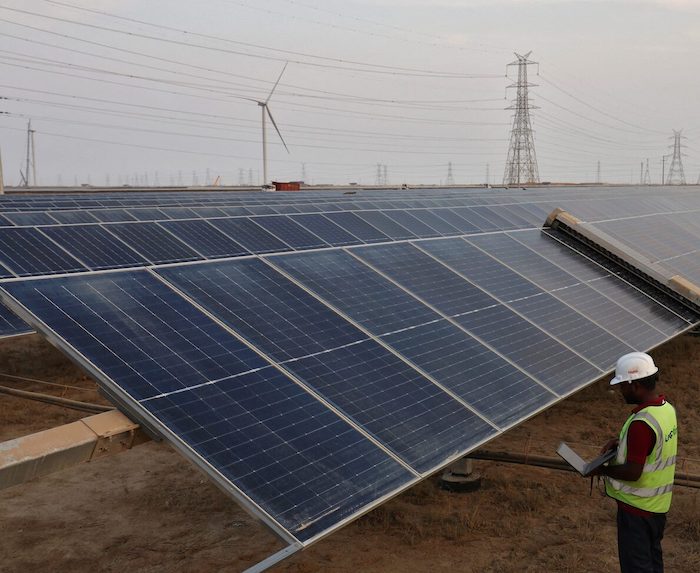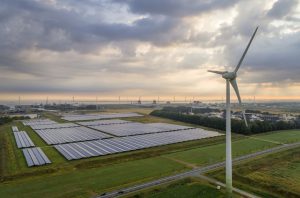Bribery claims against India’s Adani Group have revealed that renewable energy developers face a growing problem in the country finding buyers for the power they generate.
India’s central government wants to shift from polluting coal-fired generation to solar and wind, but officials say power distribution companies owned by state governments have dragged their heels on striking renewable purchase deals.
US authorities allege that billionaire Gautam Adani devised a $265-million scheme to bribe Indian state government officials to secure solar power supply deals, after one of his companies was unable to secure buyers for a $6-billion project for several years. The Adani Group has denied the charges.
ALSO SEE: Adani Bonds Sink, Indian Parliament Shuts Amid Bribery Uproar
But the conglomerate is not alone in facing increasingly long delays in signing up buyers for the renewable power now being developed in coal-dependent India – the world’s third-largest emitter of greenhouse gases.
Coal accounted for 75% of India’s power generation during the year to the end of March, with renewables such as solar and wind, but not including hydroelectricity, making up about 12%.
State grids not ready for renewables
India is still more than 10% short of its much-publicised pledge to add 175 gigawatts (GW) of renewable power by 2022. That has led the federal government to ramp up bidding for renewable projects to meet an ambitious 2030 target of increasing its non-fossil fuel capacity to 500 gigawatts (GW).
In the five years to March 2028 it plans to tender for more than four-times the capacity of renewable energy projects it commissioned in the preceding five.
To push states to help meet India’s overall goal, New Delhi in 2022 introduced so-called renewable purchase obligations (RPOs), which mandate that states increase clean energy adoption so that the national share doubles to 43.3% in March 2030.
Honouring these RPOs would require 20 of the 30 provinces monitored to more than double the share of green power in their electricity mix, a February report by government think-tank NITI Aayog showed.
The problem is that India’s states are unprepared for the rapid rise in renewable generating capacity – they lack adequate transmission infrastructure and storage and would rather rely on fossil fuel for supply than risk “intermittent” renewables.
Industry leaders say the solar sector is also grappling with inadequate government funding and a skills shortage. Makers of solar panels, cells and storage batteries face rising costs, which could threaten India’s ability to reduce its carbon footprint and meet its climate commitments.
The Modi government has imposed 40% tariffs on Chinese solar panels and 25% on cells, while allocating about $3 billion in production-linked incentives for local manufacturers as part of a plan for net-zero carbon emissions by 2070.
But New Delhi needs to boost its funding and training programs to meet its clean energy goals, industry chiefs say.
Shortage of skilled manpower
Another major problem is the shortage of skilled manpower, said Dwipen Boruah, managing director of renewables consultancy firm GSES India, which has trained over 7,000 people in renewable technologies and wants New Delhi to substantially lift subsidies for education and training in the sector.
“Hundreds of private institutes exploit these subsidies but offer subpar training,” he said, adding that small subsidies – often just a few thousand rupees per student – hinder effective education.
Boruah and other industry executives note that while India produces over a million engineering graduates annually, traditional colleges are not equipped to teach solar, wind and other renewable technologies.
Some executives say the government’s current training budget of around 5-6 billion rupees should be ramped up by a factor of 10.
Two weeks ago, Pralhad Joshi, India’s minister for renewable energy, announced the formation of a joint panel with industry representation to address key issues, including training, to meet clean energy targets.
The renewable industry faces a skill gap of around 1.2 million, with demand expected to rise by 26% creating a need for 1.7 million skilled workers by 2027, according to TeamLease Services, a staffing company, working with industry and government on training.
“The skill gap spans all levels of industry,” especially in emerging technologies like cell manufacturing, battery storage, and advanced grid integration, said Ashwani Sehgal, president, Indian Solar manufacturers Association.
“Industry is facing near 20% attrition of talented workers annually, posing a risk to production plans.”
Earlier this year, the government proposed to step up support for upskilling and relax visa restrictions on Chinese technicians, after many firms said that costly imported machines were lying unused due to lack of skilled workers.
Vaishali Nigam Sinha, co-founder of ReNew, one of India’s largest renewable firms with nearly 10 GW of capacity, said skills shortage is one of the most “underestimated barriers” to energy transition.
“The lack of skilled engineers, technicians, and project managers is pushing up operational costs,” she said, a concern echoed by several industry executives.
Tata Power, with 6 GW of renewable capacity, has set up 11 training facilities, training 300,000 youth in solar installations, battery management, and other green technologies.
“A skilled workforce is essential for accelerating project deployment, ensuring efficient operations and maintenance and driving technological innovation,” said Himal Tewari, company’s chief human resources officer.

Mismatch in power demand and states’ infrastructure
The challenges faced by Adani Green, India’s largest renewable energy company, have been stark. It took the firm nearly 3.5 years to strike supply deals with buyers for the entire 8 gigawatts (GW) of solar power capacity it won in a tender widely publicised as the country’s biggest.
R Srikanth, an energy industry adviser and dean at India’s National Institute of Advanced Studies, says setting targets for tenders and issuing contracts is “meaningless” if interest from power distribution companies is so low.
And the allegations that Adani now faces are likely to cause a further renewables slowdown, as low-cost finance from foreign investors may become more difficult to secure, Srikanth said.
A change in the way some tenders are run has exacerbated delays in the time it takes to complete renewables projects.
The tender won by Adani Green was the first major contract issued by state-run Solar Energy Corp of India (SECI) without a state-guaranteed Power Purchase Agreement (PPA).
When announced in June 2019, SECI said buyers were guaranteed, but it withdrew the provision from the deal signed a year later.
SECI’s chairman told Reuters last month that a three-fold increase in tendering of renewable projects has left 30 GW of projects for which bidding is complete, but without buyers.
“You can’t expect the states to respond and start signing three times the power supply agreements,” R P Gupta told Reuters in an interview, adding that a “demand pool has to be created” and states had to be “sensitised” to renewables.
Brokerage JM Financial said that it now takes 8 to 10 months to sign power supply deals after a contract is awarded.
By comparison, companies that were awarded contracts between July 2018 and December 2020 needed around three months to strike supply deals, SECI data showed.
“The sudden surge in bids, large pipeline of projects under construction, mismatch in power demand and bid-pipeline … and constraints in timely execution of projects are leading to delays in signing,” JM Financial said.
Renewable energy projects have also seen cancellations, with about 4%-5% of all tendered projects annulled, and backlogs in transmission infrastructure development, Gupta said.
One solution, said Rakesh Nath, former chairman of India’s Central Electricity Authority, would be knowing how much power buyers want before projects are bid for.
“Taking buyers into confidence before inviting bids may minimise delays in signing power supply agreements,” he said.
- Reuters with additional editing by Jim Pollard
ALSO SEE:
Bangladesh Wants Legal Help For Probe Into Adani, Power Deals
Adani Scandal Ups Risk to Global Banks, India’s Renewables Push
India’s Solar, Wind Power Surge Amid Green Target Chase
Indian Oil Tycoon Says New Energy Will Earn As Much As Refineries
Climate Change ‘Fuelled’ Rain That Led to Fatal Indian Landslides
India Now the World’s Third Biggest Generator of Solar Power
China’s Solar Sector Seen Facing Years of Oversupply, Low Prices
China Wind, Solar Capacity Set to Outstrip Coal For First Time
























